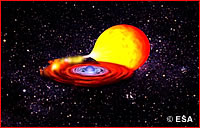ESA's XMM-Newton telescope unlocking secrets of neutron stars
Many scientists believe that neutron stars may hold the key to how the universe began in the fractions of seconds after the Big Bang, and now, with the help of the European Space Agency's (ESA) XMM-Newton telescope, they are closer to finding out the truth about these curious objects. Neutron stars are extremely dense - so dense, in fact, that a piece the size of a sugar cube weighs over one billion tonnes. One theory is that in the core of these stars the normal building blocks of atoms - protons, electrons, and neutrons - have fused together to create a plasma of dissolved matter. Some believe this plasma was created at the birth of our universe, and could reveal many important insights. In order to try and prove the existence of this substance, researchers had to learn more about the nature of matter in neutron stars. In order to calculate the density of matter in an object, it is necessary to know precisely its radius-to-mass ratio. Until XMM-Newton, no instrument has been able to take such readings from neutron stars, but the ESA's advanced x-ray telescope was able to do so using a breakthrough technique. This was achieved by calculating the stars compactness in an indirect way, by measuring its 'red shift'. The gravitational pull of a neutron star is immensely strong, and causes light particles emitted by the star to lose energy, a process known as the gravitational red shift. In measuring accurately this process for the first time, XMM-Newton finally revealed the density of a neutron star. Fred Jansen, an ESA XMM-Newton project scientist, said of the achievement: 'This is a highly precise measurement that we could not have made without both the high sensitivity of XMM-Newton and its ability to distinguish details.' According to NASA's Jean Cottam, the main author of the discovery: 'attempts to measure the gravitational red shift were made right after Einstein published the General Theory of Relativity, but no-one had ever been able to measure the effect in a neutron star, where it was supposed to be huge. This has now been confirmed.' As to whether neutron stars do contain an exotic plasma of dissolved matter created during the first moments of the universe's existence, first results suggest otherwise. Neutron stars appear to be made up of normal matter, but the scientists involved on the project stress that these results are not conclusive, and describe the results as 'a first step' in unlocking the secrets of these mysterious stars.



